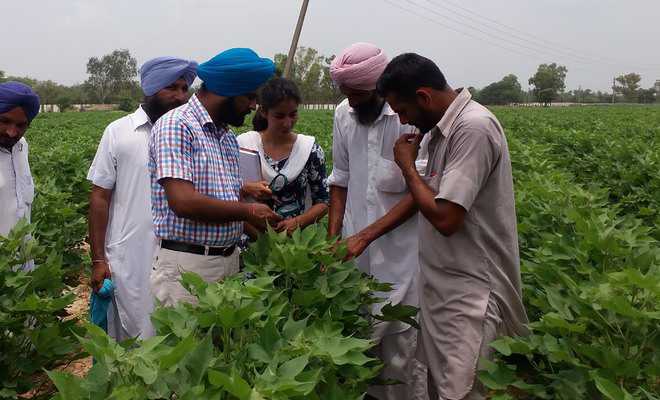Tribune News Service
Bathinda, July 26
The light drizzles have increased humidity and the fear of whitefly among the farmers as warm temperature suits whitefly.
A number of farmers in Mansa and Bathinda districts are complaining the whitefly attack. Following the attack, a few farmers have uprooted their cotton crop, citing the reason of damaged due to whitefly. However, the Agriculture Departments in both districts denied the claims of the farmers.
The officials of the Agriculture Department in Bathinda conducted a survey in several villages and also organised camps to keep check on whitefly.
Agricultural Development Officer Jaskaran Singh, who organised a camp in Gulabgarh village of Bathinda, said the drizzle had increased humidity while the warm weather has also made favourable conditions for pests including whitefly and Jassid.
Jaskarn Singh, said, “Till date, whitefly is under control as it has not crossed the Economic Threshold (ET) level which is six whitefly pest per leaf. The Jassid attack is also witnessed in some villages but that has not crossed ET level while only in a few areas, it has been noticed above the ET level. The Jassid pests are also sucking pests and farmers are advised to spray over the crop where the Jassid pest is witnessed above the ET level.”
“The farmers are spraying neem as recommended by the Agriculture Department and it has controlled the whitefly attack over the cotton crop. The farmers are advised to boil 10 kg of neem in 15 litres of water and that should be reduced to 10 litres after boiling. The reduced 10 litres of neem water should be mixed with 100 litres of water and sprayed on the cotton crop affected with whitefly in around two acres,” said agriculture supervisor Ramandeep Kaur.
The area under cotton this year has already reduced following the last year’s whitefly attack that damaged the entire cotton crop in the cotton belt.
Most of these farmers, who have decided not to sow BT cotton this year, have switched either to desi cotton or to the paddy crop.
In Bathinda, this year cotton is sown in around 95,000 hectares of land whereas last year the area under cotton was 1.12 lakh hectares. Similarly, in Mansa around 67,000 hectare area is sown under cotton against 73,000 hectare area as compared to last year. Whereas, the farmers here, too, preferred desi cotton and the area under desi cotton has increased this year to 2,000 hectares against the 500 hectares last year.
The government has recruited around 130 scouts for 284 villages which are considered as a unique step to counter whitefly. These scouts are aware of the cotton crop as they are belonged to the agricultural families.
The scouts will inform the Agriculture Department about the status of whitefly and will report the department about the crop in their village every day.
Shingara Singh Mann, president of the BKU (Ekta) Ugharan said, “At this moment, the rain will be proved beneficial for the crop. But, for the past many days there has been no sign of rain. The whitefly attack is severe in many villages and farmers in Bathinda and Mansa districts have uprooted their cotton crop above 250 acres following the whitefly attack again this year. The administration is not serious to control whitefly as the government wants to kill farmers with its wrong policies. The neem is no more effective over the cotton crop to control whitefly in villages.”
Unlock Exclusive Insights with The Tribune Premium
Take your experience further with Premium access.
Thought-provoking Opinions, Expert Analysis, In-depth Insights and other Member Only Benefits
Already a Member? Sign In Now










